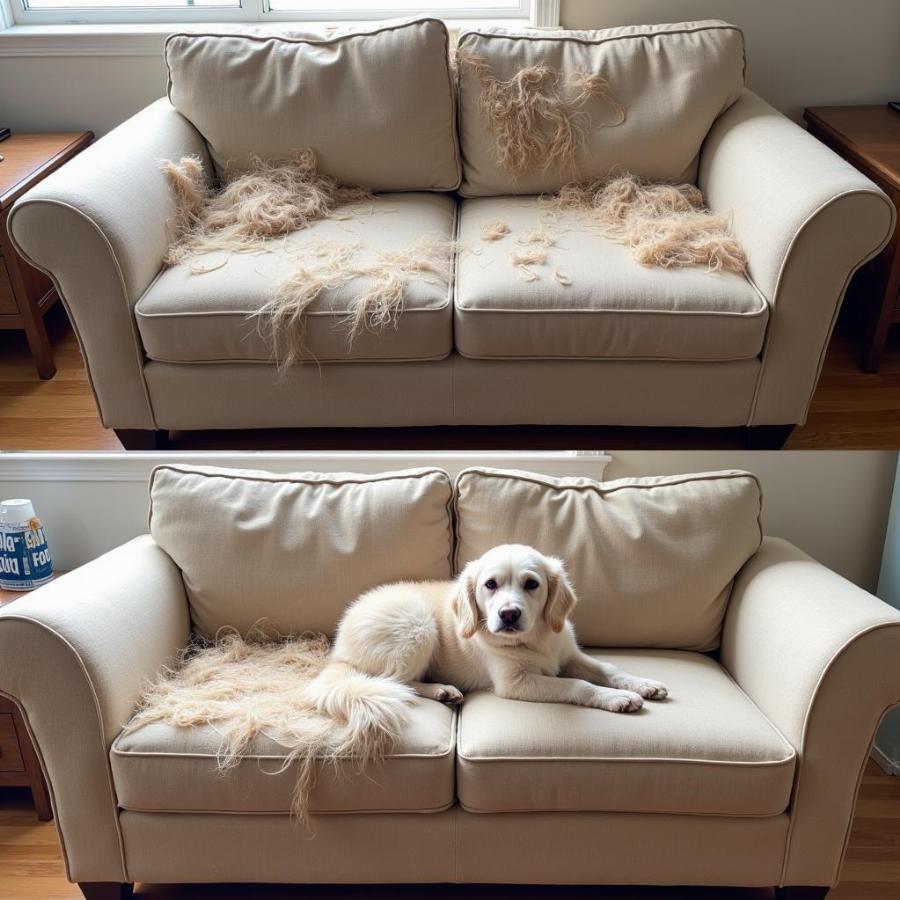“I hate it when my dog melts!” This is a common lament among dog owners, often uttered while surveying a landscape of fur tumbleweeds across their homes. While dogs don’t literally melt, the amount of shedding can sometimes feel like they are dissolving into fluff. This article explores why dogs shed, what “melting” really means, and how to manage this furry phenomenon for a cleaner, happier home.
Understanding Why Dogs Shed
Shedding is a natural process for dogs, just like it is for humans. It’s how they get rid of old or damaged hair and make way for new growth. The amount a dog sheds depends on several factors including breed, time of year, health, and diet. Double-coated breeds, like Huskies and German Shepherds, are notorious for their dramatic seasonal “blowouts” where they shed their thick undercoats in preparation for warmer weather. Other breeds might shed more consistently throughout the year.
Is Excessive Shedding a Sign of a Problem?
While some shedding is normal, excessive shedding can sometimes indicate an underlying health issue. Allergies, parasites, stress, poor nutrition, and certain medical conditions can all contribute to increased hair loss. If you notice a sudden or dramatic increase in shedding, or if your dog’s skin appears irritated or inflamed, it’s crucial to consult a veterinarian.
Managing the “Melt”: Tips for Controlling Dog Shedding
“How do I stop my dog from melting all over my house?” is a question many owners ask. While you can’t completely stop shedding, you can effectively manage it. Here’s how:
- Regular Brushing: This is the single most effective way to control shedding. Brushing removes loose hair before it lands on your furniture and clothes. The frequency of brushing depends on your dog’s breed and coat type.
- A Healthy Diet: A balanced diet rich in essential fatty acids and high-quality protein can promote healthy skin and coat, reducing excessive shedding.
- Bathing: Occasional baths can help loosen and remove dead hair. However, over-bathing can strip the coat of its natural oils and actually worsen shedding.
- Specialized Tools: Deshedding tools, like rakes and shedding blades, can be particularly effective for double-coated breeds.
- Professional Grooming: Regular professional grooming can help manage shedding, especially for breeds with complex coat care needs.
Living with a Shedding Dog: Practical Tips for a Cleaner Home
Accepting that some shedding is inevitable is the first step. Here are some practical tips for minimizing the impact of shedding on your home:
- Invest in a good vacuum cleaner: A vacuum with strong suction and a pet hair attachment is essential.
- Use lint rollers: Keep lint rollers handy for quick cleanups on clothes and furniture.
- Choose furniture wisely: Opt for furniture materials that are easy to clean and don’t trap hair. Leather or microfiber are good choices.
 Sofa và lông chó
Sofa và lông chó - Wash bedding frequently: Wash your dog’s bedding, as well as your own, frequently to remove hair.
- Designated dog areas: Create designated areas for your dog to relax, and use washable covers or blankets in those areas.
Conclusion
While the phrase “I hate it when my dog melts” humorously captures the frustration of dog shedding, understanding the reasons behind it and implementing effective management strategies can help you maintain a cleaner, happier home, and strengthen the bond with your furry friend. Regular grooming, a healthy diet, and some practical housekeeping adjustments can significantly reduce the “melting” effect and allow you to fully enjoy the companionship of your beloved dog.
FAQ
- Why does my dog shed so much? Several factors contribute to shedding, including breed, season, diet, and overall health.
- Is it normal for my dog to shed year-round? Some breeds shed consistently throughout the year, while others have more pronounced seasonal shedding.
- How often should I brush my dog? The frequency of brushing depends on your dog’s breed and coat type.
- What can I do to reduce shedding? Regular brushing, a healthy diet, and occasional baths can help manage shedding.
- When should I be concerned about excessive shedding? Consult a veterinarian if you notice a sudden increase in shedding or skin irritation.
Suggested Further Reading
- You might find our article on “pictures of cocker spaniel dogs” interesting if you are considering a breed known for its beautiful coat.
Beaut Dogs: Your Comprehensive Guide to the Canine World
Beaut Dogs is your one-stop resource for all things canine. We provide expert advice and helpful information on various dog breeds, their care, and much more. When you need expert advice, contact us at Email: [email protected] to get detailed and accurate answers from Beaut Dogs.